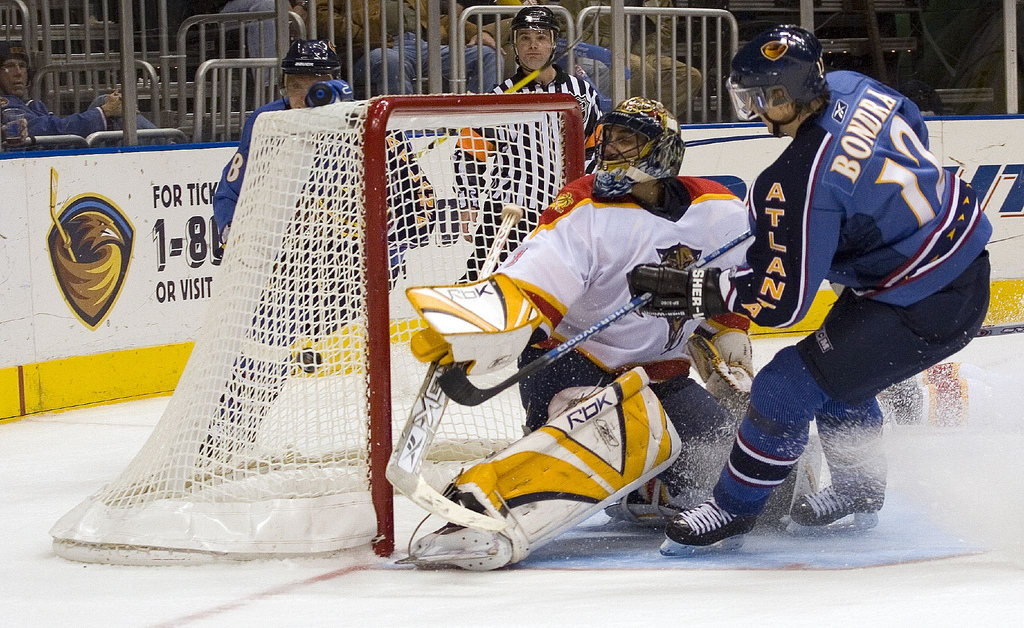|
Rush Goalie
Rush goalie, also known as a fly goalie or fly keeper and in some parts of the UK, goalie wag or nearest dearest, is a variation of association football in which the role of the goalkeeper is more flexible than normal. The goalkeeper position is taken by any player who can run out of and leave their goal to actively participate in outfield play. However, when defending the player returns to their goal and takes up the role of goalkeeper once again; in rush goalie only one player can be the goalkeeper and handle the ball. Once the danger has passed, that player (the "rush goalie") returns to normal outfield play. Rush goalie is only played in informal football matches, usually by children, and often when the players want to play a more active role in the game than the position of goalkeeper would normally allow; it can also be applied when the number of players per side is low. A rush goalie system can also be used as a way of leveling out teams when playing with an uneven number of ... [...More Info...] [...Related Items...] OR: [Wikipedia] [Google] [Baidu] |
Association Football
Association football, more commonly known as football or soccer, is a team sport played between two teams of 11 players who primarily use their feet to propel the ball around a rectangular field called a pitch. The objective of the game is to score more goals than the opposition by moving the ball beyond the goal line into a rectangular framed goal defended by the opposing side. Traditionally, the game has been played over two 45 minute halves, for a total match time of 90 minutes. With an estimated 250 million players active in over 200 countries, it is considered the world's most popular sport. The game of association football is played in accordance with the Laws of the Game, a set of rules that has been in effect since 1863 with the International Football Association Board (IFAB) maintaining them since 1886. The game is played with a football that is in circumference. The two teams compete to get the ball into the other team's goal (between the posts and under t ... [...More Info...] [...Related Items...] OR: [Wikipedia] [Google] [Baidu] |
Goalkeeper (association Football)
In many team sports which involve scoring goals, the goalkeeper (sometimes termed goaltender, netminder, GK, goalie or keeper) is a designated player charged with directly preventing the opposing team from scoring by blocking or intercepting opposing shots on goal. Such positions exist in bandy, rink bandy, camogie, association football, Gaelic football, international rules football, floorball, handball, hurling, field hockey, ice hockey, roller hockey, lacrosse, ringette, rinkball, water polo, and shinty as well as in other sports. In most sports which involve scoring in a net, special rules apply to the goalkeeper that do not apply to other players. These rules are often instituted to protect the goalkeeper (being a target for dangerous or even violent actions). This is most apparent in sports such as ice hockey, field hockey, and lacrosse, where goalkeepers are required to wear special equipment like heavy pads and a face mask to protect their bodies from the imp ... [...More Info...] [...Related Items...] OR: [Wikipedia] [Google] [Baidu] |
Goal (sport)
In sport, a goal may refer to either an instance of scoring, or to the physical structure or area where an attacking team must send the ball or puck in order to score points. The structure of a goal varies from sport to sport, and one is placed at or near each end of the playing field for each team to defend. For many sports, each goal structure usually consists of two vertical posts, called ''goal posts'', supporting a horizontal ''crossbar''. A ''goal line'' marked on the playing surface between the goal posts demarcates the goal area. Thus, the objective is to send the ball or puck between the goal posts, under or over the crossbar (depending on the sport), and across the goal line. Other sports may have other types of structures or areas where the ball or puck must pass through, such as the basketball hoop. Sports which feature goal scoring are also commonly known as invasion games. In several sports, sending the ball or puck into the opponent's goal structure or area is th ... [...More Info...] [...Related Items...] OR: [Wikipedia] [Google] [Baidu] |
Penalty Area
The penalty area or 18-yard box (also known less formally as the penalty box or simply box) is an area of an association football pitch. It is rectangular and extends 16.5m (18 yd) to each side of the goal and 16.5m (18 yd) in front of it. Within the penalty area is the penalty spot, which is 11m (12 yd) from the goal line, directly in-line with the centre of the goal. A penalty arc (often informally called "the D") adjoins the penalty area, and encloses the area within 9.15m (10 yd) of the penalty spot. It does not form part of the penalty area and is only of relevance during the taking of a penalty kick, when any players inside the arc are adjudged to be encroaching. Within the penalty area is another smaller rectangular area called the ''goal area'' (colloquially the ''"six-yard box"''), which is delimited by two lines starting on the goal-line from the goalposts and extending into the pitch from the goal-line, and the line joining these. Goal kicks and any free kick by ... [...More Info...] [...Related Items...] OR: [Wikipedia] [Google] [Baidu] |

.jpg)

